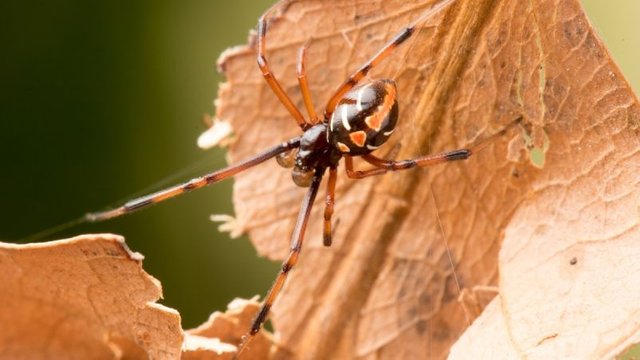Black Widow Spiders Are Spreading Farther North Than Ever Before

Using photos snapped by citizen scientists, Canadian researchers have documented the northerly spread of black widows into regions not typically known to host these spiders, whose bites can cause severe pain.
An updated species distribution map published this week in a new PLOS One study shows that the northernmost range of black widow spiders (Latrodectus variolus) has increased by about 31 miles (50 km) over the past 60 years. Because climate is a major factor in terms of where black widows can live, the researchers suspect climate change has something to do with its expanding habitat.
Species distribution maps, which show the geographic range of a specific species, are typically put together from data collected by field biologists, who scour the landscape in search of their target animal. But this method is time consuming, tedious, and often insufficient, leading to inaccurate maps. To get around this limitation, a research team led by Yifu Wang from McGill University in Montreal created an updated species distribution map by looking at museum collections around North America, and by using an often neglected resource: non-scientists with smartphones.
“In our project, the citizen science data was essential in modeling distributions of spiders,” said McGill professor and study co-author Christopher Buddle in a statement. “People who are excited about discovering where species live can contribute in meaningful ways to scientific progress and this is exciting, important, and is changing how we do research.”
Using statistical tests and modeling tools, the researchers removed anomalous or questionable observations from the database, which includes observations made from 1960 through to 2016. Data produced by citizen scientists began to appear after 1990. The team also compared the updated distribution map to previous ones to see how the range of the black widow spider’s range has changed over time. The same process was used to map the location and spread of another spider, the black purse-web spider (Sphodros niger). Together, they’re considered the first reliable distribution maps of the two species, showcasing the importance of data collected by people without scientific training.
The new research shows that the northern edge of the black widow’s habitat appears to be increasing over time, spreading into eastern Ontario and into Quebec. The purse-web spider’s range is likewise moving north, shrinking in the southwest corner of the United States while spreading northward beyond its usual habitat.
Climatic factors are likely responsible for the shifting habitats. For black widows, the most important factor for predicting their environmental range is the mean temperature of the warmest three months of the year, while for the purse-web spider it’s the coldest three months. “Climate change, which influences seasonal temperature pattern, could be a strong contributor to the increase in occurrences of Northern black widow beyond their historical northern limit,” the researchers write in the study.
These updated observations mean that health officials in regions not accustomed to seeing the black widow need to be prepared. Black widows like to build webs between objects, and bites, while rare, typically happen when humans come into direct contact with these webs, according to the US Center for Disease Control. A black widow bite can be distinguished by two puncture marks on the skin. The venom causes pain at the bite area, which then spreads to the chest, abdomen, or the entire body. The CDC says bites from black widows aren’t usually life-threatening for adults, but they can cause severe pain and aching muscle contractions. People who have been bitten by a black widow are advised to seek professional medical attention, and also clean the bite area with soap and water, apply a cold cloth to reduce swelling, elevate the bite area if possible, and to refrain from trying to remove the venom themselves.
It’s very likely, the researchers say, that the black widow’s range is even greater, extending yet another 30 miles (50 km) north, possibly as far as Montreal (where no sightings have been made to date). The next step is to conduct further sampling efforts in habitats associated with these spiders.
“We propose to call on citizen scientists by launching a monitoring project through a platform such as BugGuide and iNaturalist to produce a large-scale sampling effort,” said Wang. “This would represent a rapid, low-cost, highly efficient, and innovative way to test these large-scale predictive models.”
Black widow spiders may be small, but they’re easy to identify. For you citizen scientists out there, these spiders have a distinctive red hourglass shape on the underside of their abdomen, and they sometimes feature white slash marks on their back. They’re typically found in undisturbed placed and areas where debris has accumulated, such as in wood piles, under eaves, and on fences. They also like to hang around in outdoor toilets, where flies are abundant. When documenting a black widow (or any other creature for that matter), it’s a good idea to take multiple photos from different angles, include a size reference like a coin, and include geographic location. And of course, be careful to not get bitten.
Collected
Congratulations @sufiun! You have received a personal award!
Click on the badge to view your Board of Honor.
Do not miss the last post from @steemitboard: